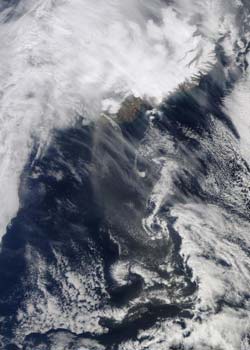NASA's Terra satellite keeps eye on Eyjafjallajökull's ash plume

The MODIS instrument on NASA\'s Terra satellite captured a visible image of the ash plume (brown) drifting south and east from Eyjafjallajökull volcano in Iceland at 11:55 UTC (7:55 a.m. EDT). Credit: NASA\'s MODIS Rapid Response Team<br>
The Moderate Resolution Imaging Spectroradiometer (MODIS) instrument on NASA's Terra satellite captured visible image of the ash plume (consisting of fine particles of pulverized rock) at 11:55 UTC (7:55 a.m. EDT). The plume appeared to be lighter in color than the previous few days, and it was drifting south and east over the Northern Atlantic Ocean.
NASA works with other agencies on using satellite observations to aid in the detection and monitoring of aviation hazards caused by volcanic ash. For more on this NASA program, visit:
http://science.larc.nasa.gov/
asap/research-ash.html
The MODIS Rapid Response System was developed to provide daily satellite images of the Earth's landmasses in near real time. The MODIS Rapid Response Team that generates the images is located at NASA's Goddard Space Flight Center in Greenbelt, Md.
Media Contact
More Information:
http://www.nasa.govAll latest news from the category: Earth Sciences
Earth Sciences (also referred to as Geosciences), which deals with basic issues surrounding our planet, plays a vital role in the area of energy and raw materials supply.
Earth Sciences comprises subjects such as geology, geography, geological informatics, paleontology, mineralogy, petrography, crystallography, geophysics, geodesy, glaciology, cartography, photogrammetry, meteorology and seismology, early-warning systems, earthquake research and polar research.
Newest articles

A universal framework for spatial biology
SpatialData is a freely accessible tool to unify and integrate data from different omics technologies accounting for spatial information, which can provide holistic insights into health and disease. Biological processes…

How complex biological processes arise
A $20 million grant from the U.S. National Science Foundation (NSF) will support the establishment and operation of the National Synthesis Center for Emergence in the Molecular and Cellular Sciences (NCEMS) at…

Airborne single-photon lidar system achieves high-resolution 3D imaging
Compact, low-power system opens doors for photon-efficient drone and satellite-based environmental monitoring and mapping. Researchers have developed a compact and lightweight single-photon airborne lidar system that can acquire high-resolution 3D…





















